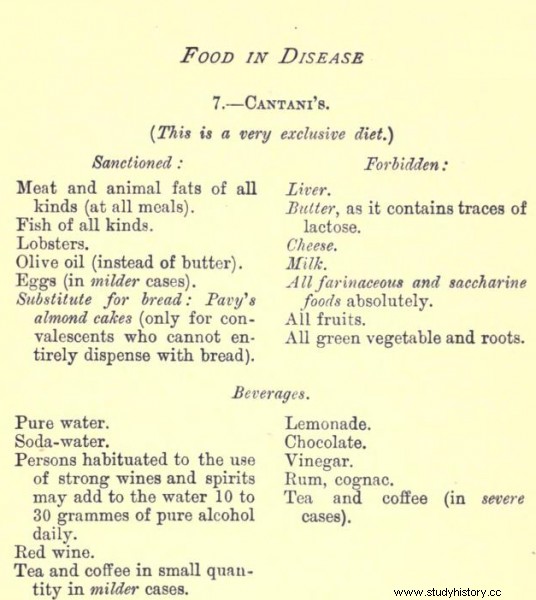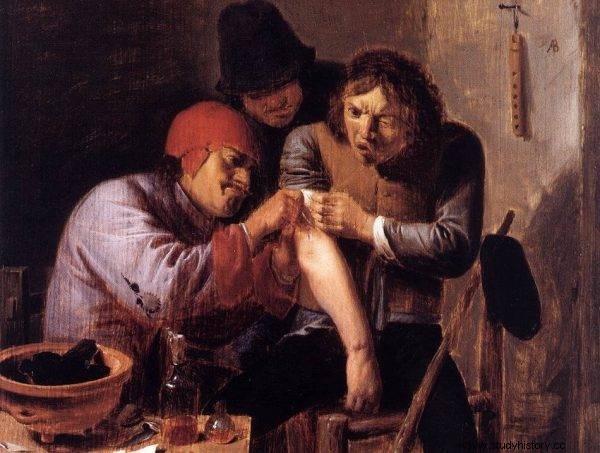For centuries, being diagnosed with diabetes was a death sentence. Patients were intoxicated with alcohol and drugs, starved and stuffed with carcinogenic substances.
The earliest records of diabetes are found in the writings of ancient Chinese, Hindu and Egyptian medics. In the Ebers papyrus of 1550 B.C.E. we read, for example, about "a rare disease in which the patient quickly loses weight and urinates very often" . Ancient Greek physicians, such as Apollonius of Memphis and Demetrius of Apamea, also wrote of a disease that deprived the patient of more fluid than he could ingest. On the other hand, Areteus of Cappadocia (1st century CE) was probably the first to give a full description of the symptoms of a disease in which there was "the disappearance of the body and the passage of its contents into the urine." He noted that "sick people feel their guts consumed by fever [...], cachexia occurs quickly, followed by death".
Treatments as recommended in the modern age can give you a headache and twist in your bowels. Especially since many of the widely used drugs were… dangerous poisons.
Horseback riding - yes. Sex - by no means!
Diabetes was not understood. Its causes were first searched for in the kidneys and bladder, and over the centuries, also in the liver and stomach. Despite this, the medics did not stop trying to help the suffering. And so the Egyptians tried to treat diabetes with a diet of beer, fruit, seeds and honey. This was to stop excessive urination. The Greeks recommended wine diluted with water and cool compresses. In more difficult cases, the patient was given opium and mandrake. The strangest - although justified by humoral medicine - drugs were viper jelly or crushed red coral ( Corallium rubrum ).
The Byzantine physician and surgeon, Paul of Aegina, who practiced in the 7th century, prescribed his patients a herbal tincture with endive, lettuce, knotweed and oman, along with dates and myrtle. For the kidneys, where he saw the source of the disease, he recommended poultices containing vinegar, rose oil and spring illusions. An actuary who at the turn of the 13th and 14th centuries was the court physician in Constantinople, where he wrote his famous dissertation on urinoscopy ( Περί Ουρων , Latin De Urinis ), he treated his patients with rose water.

The Egyptians tried to treat diabetes with a diet of beer, fruit, seeds and honey.
He described Avicenna in the Canon of Medicine (1025) symptoms of diabetes mellitus - including sexual dysfunction and gangrene. He also developed a mixture of lupine, fenugreek and turmeric . (Interestingly, these substances are still used today to lower blood sugar). He also recommended anti-emetic and diaphoretic medications and moderate exercise (for example, horse riding). In contrast, another recognized Persian physician, a little earlier practitioner Abu Bakr Muhammad ibn Zakarijja ar-Razi (865-925), also known as Rhazes, absolutely advised against exercise. And he definitely forbade his patients to have sex.
Beetlejuice and gummy products
Paracelsus (1493–1541), who is hard to deny scientific meticulousness and broad - for his time - medical knowledge, argued that diabetes is a kidney disease resulting from a humoral imbalance. "It is nothing more than an excessive need to pass urine, and the reason for this is overheating of the kidneys" - he wrote . In his opinion, steam baths could be helpful, so he recommended his patients to visit the baths regularly.
A similar approach was followed by the English physician Thomas Willis (1621–1675), one of the fathers of neurology. He argued that "treating [diabetes] should lead to the thinning of the blood and supply of the lost salts." In addition to opiates, which he prescribed to his patients left and right, he also recommended them a diet of "milk, rice, starchy and gummy products " ". A practitioner in the same period, Thomas Sydenham (1624–1689), known as the "English Hippocrates", treated his patients with diarrhea and narcotic substances known since ancient times.

Almost a hundred years later, in 1776, the English physician Matthew Dobson proved that diabetics excrete sugar in their urine.
Almost a hundred years later, in 1776, the English physician Matthew Dobson proved that diabetics excrete sugar in the urine. He published a description of an experiment in which the patient's urine evaporated to give white granules with the smell and taste of cane sugar, published in Medical Observations and Inquiries.
He also found sugar in his blood, so he concluded that the disease is the result of "impaired digestion and absorption" . He tried to develop an effective therapy with rhubarb, opium or cantaridine - then widely known (and used as an aphrodisiac) poison obtained from the secretion of oleic beetles. In the spirit of ancient advice, he also wrote that the sick should take care of serenity, but definitely avoid sensual pleasures ( sint animo hilariori aegri, a Venere plane se abstineant).
Miracle Diet
Scottish military surgeon John Rollo (died 1809) published an article in 1797 Account of Two Cases of Diabetes Mellitus, with Remarks in which he described a new understanding of diabetes and treatment methods. In his opinion, the stomach was responsible for the disease, as it excessively produced sugar obtained from the consumed plant products. He therefore recommended a low-carbohydrate diet, rich in protein and fat . Patients bleed, prescribed laxatives or inducing vomiting (e.g. ammonium sulfide, opium tincture, wine with antimony, foxglove, and tobacco).

Cantani kept his patients locked up to be safe. He would not allow them to eat anything but meat and various types of fats
Doctors Apollinaire Bourchardat (1806–1886) and Arnoldo Cantani (1837–1893) also used restrictive diets and fasts in their patients. Bourchardat in the book De la Glycosurie ou Diabète Sucré He recommended that patients "eat as little as possible, chewing each bite thoroughly." The medications he prescribed included sodium bicarbonate, chalk, and ammonium and potassium salts. In turn, Cantani kept his patients safe. He would not allow them to eat anything other than meat and various types of fats. In milder cases, it allowed to include eggs, liver and seafood in the diet. Only water and watered drinks in amounts not exceeding 1.5-2.5 liters per day were allowed to drink.
Keto, lithium and leeches
Even more drastic therapy of this type was used by Bernhard Naunyn (1839–1925). This German doctor was the author of the monograph Der Diabetes Melitus published in 1898, important for further research on diabetes. . He locked up his patients for five months. During this time, they had to follow a strict, completely carbohydrate-free diet . In view of such recommendations, the advice of Sir William Osler (1849–1919) seems to sound like a visit to a spa. Wear flannel or silk clothing close to your skin, take a cold bath every day, and go to the Turkish bath occasionally, exercise moderately or have a massage. Well, he can make good himself and his prescriptions - he also prescribed opium to diabetics as "the only surviving trial among disease-retarding drugs" and potassium bromide, arsenic compounds, creosote and lithium salts.

Diabetes were prescribed opium as "the only surviving trial among disease-retarding drugs", as well as potassium bromide, arsenic compounds, creosote and lithium salts.
Even at the beginning of the 20th century, more or less restrictive low or no carbohydrate diets were the only effective way of prolonging life for diabetics . Which did not mean that they brought comfort and well-being. Kornel Makuszyński (1884–1953), whose books were brought up by generations of Poles, complained in a letter to prof. Jan Głębocki:
Let the Lord honestly believe that I am writing this letter to the Lord in despair. I am seriously ill with diabetes and on such a cruel and gloomy diet that I cannot move directly without the entire injection apparatus and other brawls, drenched in tears.
It is worth mentioning that Makuszyński could already use the priceless achievement of modern medicine - insulin. It was discovered in 1922 by Frederick Banting and Charles Best. In the form of injections, she saved the lives of patients.
Affectus unfortunately not so rarus
Areteus of Cappadocia, mentioned at the beginning, wrote of diabetes as "an amazing disease, not very common among people." Jacques Dubois, known as Sylvius, who died in 1555, a French physician and anatomist, teacher of Vesalius, barely ever encountered this disease in his entire life, which he also called "rare" ( affectus rarus ).
It is difficult to say how rare the described cases were, and how far the patients were never properly diagnosed and died . In addition to millions of anonymous people, for centuries rulers (eg August III Sas, Michał Korybut Wiśniowiecki), inventors (eg Thomas Edison), painters (Paul Cezanne) and writers (Jan Kasprowicz, H.G. Wells or the recently deceased Anne Rice) suffered from diabetes. Currently, almost half a billion people in the world live with this disease, or every 11th adult person. It is said that is the first non-infectious pandemic disease . In the twenty-first century, despite better and better drugs and therapies as well as the development of modern technologies, we still have not achieved the goal of its complete, non-surgical cure.
Literature:
- Barach J.H., Historical facts in diabetes , Ann Med Hist 10, 387-401, 1928.
- Barnett D.M., Krall L.P., The History of Diabetes , Joslin's Diabetes Mellitus., 14th ed., Boston, Massachusetts 2005.
- Fabian W., Koziarska-Rościszewska M., Szymczyk I., Cukrzyca , PZWL, Warsaw 2008.
- Frank L.L., Diabetes mellitus in the texts of old Hindu medicine (Charaka, Susruta, Vagbhata) , Am J Gastroenterol 27, 76-95, 1957.
- Horowitz P., The history of diabetes , N Y Med J 111:807-812, 1920.
- Korzeniowska K., Jabłecka A., Cukrzyca (Part I) , Contemporary Pharmacy 1, 231–235, 2008.
- Polonsky K.S., Diabetes mellitus over the past 200 years , N Engl J Med 367, 1332-40, 2012.
- Rollo J., Account of Two Cases of Diabetes Mellitus, with Remarks , Ann Med (Edinb) 2, 85-105, 1797.
- Tatoń J., Czech A., History of research and treatment of diabetes , Medical University of Warsaw, Warsaw 2011.
- Zinman B. et al., Diabetes Research and Care Through the Ages , Diabetes Care 40 (10), 1302-1313, 2017.
